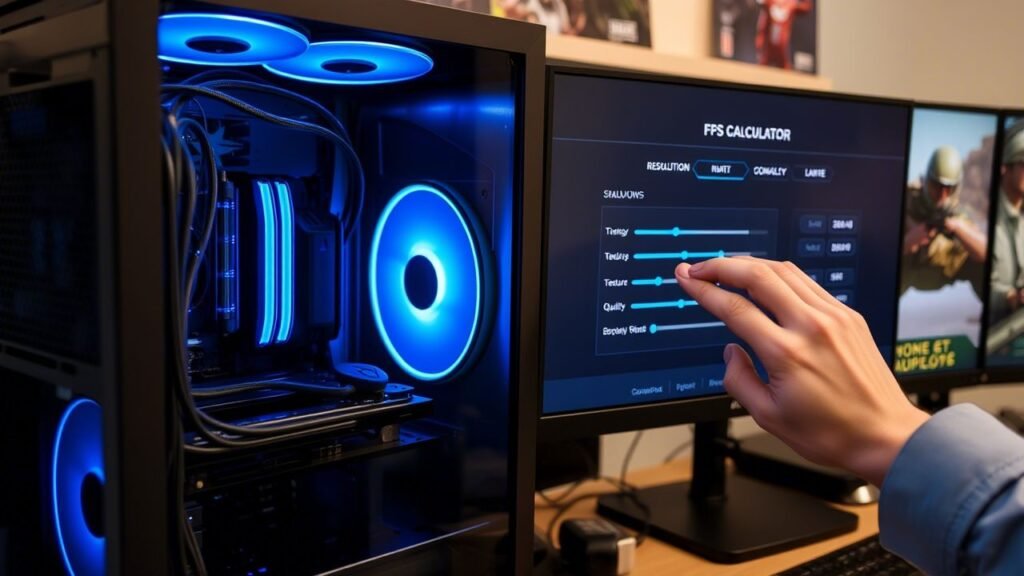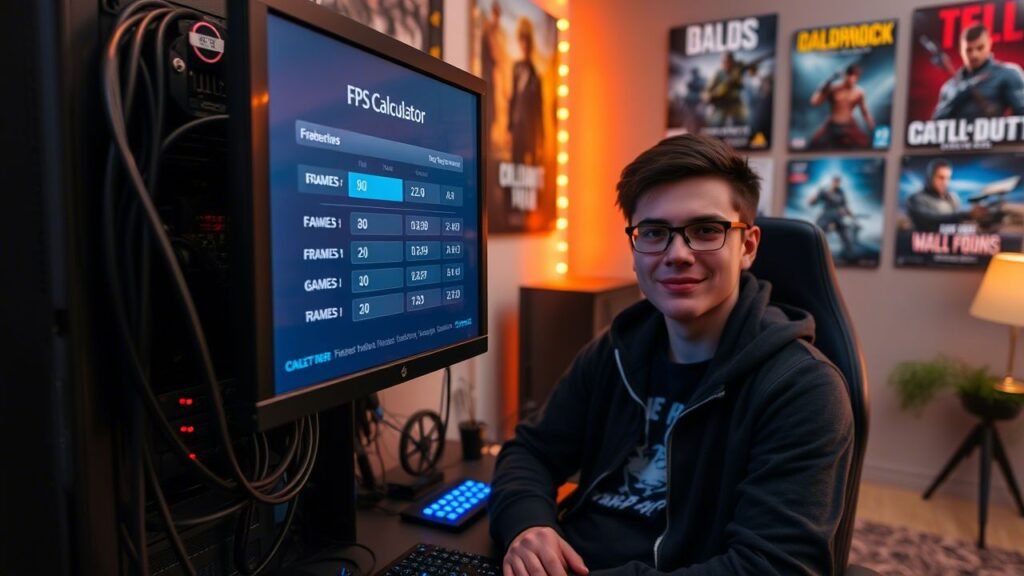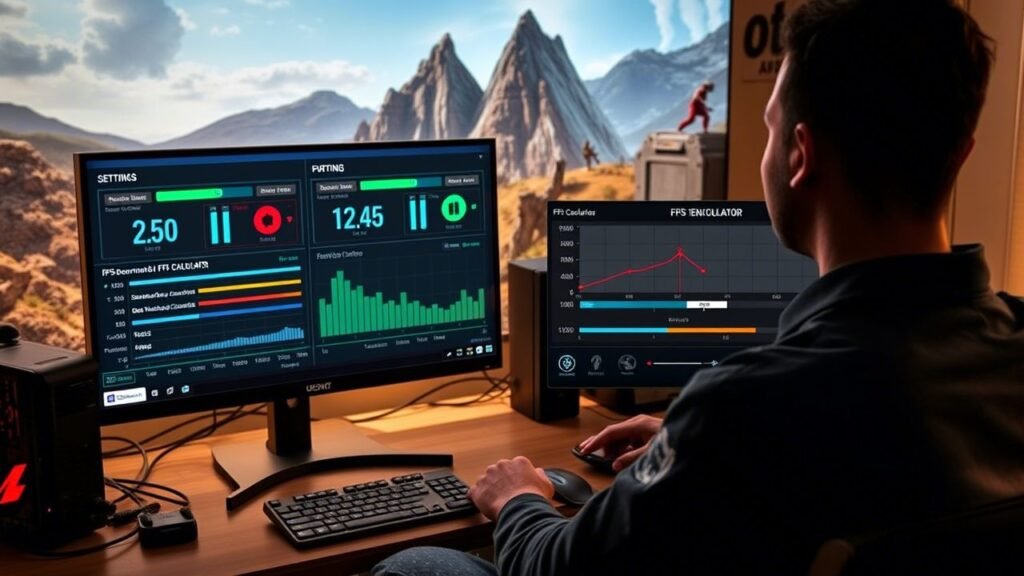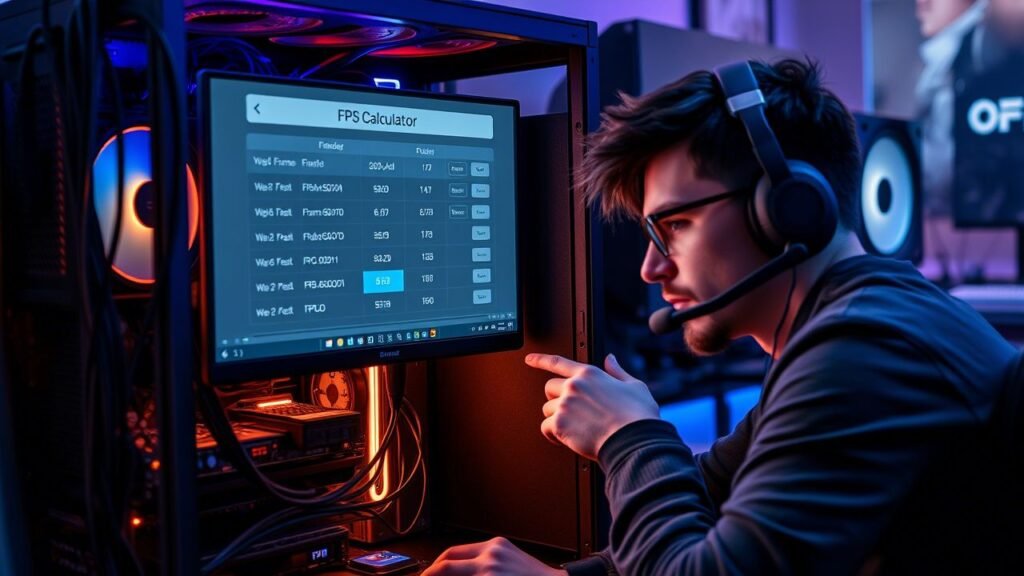FPS Calculator
Calculate your gaming performance with precision
If you’re a gamer, content creator, or just a PC enthusiast, you probably know how important FPS (Frames Per Second) is for a smooth and immersive gaming experience. But how do you know if your PC will be able to handle the latest games at your desired settings? This is where an FPS Calculator comes in handy.
What is an FPS Calculator?
An FPS Calculator is a tool that estimates the performance of your PC and how many frames per second (FPS) you can achieve in a game, based on your hardware (CPU, GPU, RAM) and game settings (resolution, graphics quality).
How does this work?
- Before buying a game or upgrading your PC, you will know how your system will run.
- By optimizing game settings, you can create a balance between good graphics and smooth gameplay.
- By understanding the shortcomings of the system, you will know what things (CPU/GPU) are hampering your performance.

Why is FPS Important in Gaming?
If you are into gaming, then you must have heard the name of FPS (Frames Per Second). This is the measurement that tells how many image frames your PC or console is able to show in every second. The higher the FPS, the smoother and better the gaming experience!
Let’s understand in simple language how FPS affects your gaming and how much FPS should be there.
1. Different levels of FPS and their effect
30 FPS – Basic level (will run, but will show jerks)
- This is the minimum standard of gaming, as many console games (like PS4/Xbox One) run at 30 FPS.
- Problems:
- Movement will feel jerky (stutter) in fast games (like Call of Duty, Fortnite).
- Mouse/controller response will feel a bit slow (input lag is high).
- Not good at all for competitive gaming.
60 FPS – Perfect Balance (Great!)
- 60 FPS is the golden spot for most gamers because:
- Gameplay is super smooth and responsive.
- Input lag is minimal, meaning your shots will register instantly.
- Most monitors (60Hz) are fully compatible.
120+ FPS – Pro level gaming (Fluid AF!)
- If you have a 120Hz/144Hz/240Hz monitor, you can enjoy 120+ FPS:
- Gaming will feel buttery-smooth (especially in fast games like Valorant, CS2, Apex Legends).
- Input lag is next to nothing, meaning your every movement and click will register instantly.
- Competitive Advantage: eSports players always use 240Hz+ monitors to make every millisecond count.
2. 1% and 0.1% Lows – Sudden drop in FPS (stuttering)
FPS is not just about average, but its consistency is also important.
- 1% Low / 0.1% Low indicates how low the worst 1% or 0.1% frames are while gaming.
- Example: If your average FPS is 100, but 1% Low is 40, the game will mostly run smooth, but sometimes sudden FPS drops will cause stuttering/lag.
- How to fix?
- Close background apps (like Chrome, Discord).
- Optimize graphics settings (reduce textures, turn on DLSS/FSR).
- If FPS drops frequently, you may need to upgrade GPU/CPU.
3. Benefits of High FPS – Why is it important?
Smooth movement: Higher FPS = more frames = game animations will look fluid.
- Low input lag: At 144 FPS, your mouse/keyboard commands will be instantly reflected on the screen (better than 60 FPS).
- Competitive advantage: Pro gamers always use 240Hz+ monitors so they can make every millisecond count.
4. How much FPS do you need? – Conclusion
- Casual gaming (GTA V, Story Games): 60 FPS is enough.
- Competitive gaming (Valorant, CS2, Fortnite): 120+ FPS + get a 144Hz/240Hz monitor.
- Focus on 1% Low: If FPS drops frequently, fix settings or upgrade hardware.
Final word: This is the basic but most important part of FPS gaming. If you want smooth and responsive gaming, never ignore FPS.

Key Features of a Good FPS Calculator
1. Hardware Selection – Choose your CPU, GPU, and RAM
A good FPS calculator lets users select their exact hardware parts, such as:
- CPU (Processor): The brain of the system that handles game logic, physics, and AI calculations. So users can choose the latest processors from Intel, AMD, or any brand.
- GPU (Graphics Card): The most important part of gaming performance, it renders graphics, textures, and effects. NVIDIA, AMD, and integrated GPUs should be supported.
- RAM (Memory): This doesn’t have much impact, but if there is less RAM, the game starts to stutter. The calculator must have options for RAM capacity (8GB, 16GB, 32GB) and speed (DDR4/DDR5).
The calculator’s hardware database must be updated to accurately predict the performance of new processors and GPUs.
2. Resolution & Graphics Settings 720p to 4K, Low to Ultra Presets
Let the calculator simulate different settings:
- Resolutions: 720p (HD), 1080p (Full HD), 1440p (QHD), 4K (UHD) – the higher the resolution, the more GPU power is required.
- Graphics Presets: Low, Medium, High, Ultra are options that adjust textures, shadows, and effects together.
This will let users know at which setting their system will give smooth FPS.
3. Advanced Customization – Fine-Tune Shadows, Anti-Aliasing, View Distance
Not just presets, advanced users should get these options:
- Anti-Aliasing (AA): Smoothens jagged edges, but puts load on the GPU (FXAA, TAA, MSAA).
- Shadow Quality: High settings look realistic, but reduce FPS.
- View Distance: How far the objects will be visible – puts load on both CPU and GPU.
- Texture Quality: Uses VRAM, more GPU memory is required for high textures.
With these options, users can optimize settings according to themselves.
4. Bottleneck Detection – Is CPU or GPU limiting?
A good FPS calculator should tell you:
- Is CPU weak? If GPU is not able to use full power, then CPU is bottlenecking.
- Is GPU weak? If CPU is strong but FPS is low, then GPU upgrade is needed.
The calculator should tell the percentage and also suggest which part would be best to upgrade.
5. Performance Rating – Is it suitable for gaming, streaming, or editing?
Not just FPS, the FPS calculator should also tell:
- Gaming: Will the system run modern games at 60+ FPS at 1080p/1440p?
- Streaming: Will the CPU/GPU be able to handle smooth streaming with gameplay? (NVENC or x264 encoding support)
- Content Creation: Is it right for tasks like video editing, 3D rendering or not?
This will let users know what their PC is best for.
6. Mobile-Friendly – Will run on both phone and desktop
Most people check specs from mobile only, so the calculator should:
- Be responsive: Looks good on every small or big screen.
- Load fast: Opens quickly even on mobile data.
- Touch-friendly: Buttons and sliders are easy to use.
If you get a smooth experience on mobile, users will use it more.
Final point: A good FPS calculator will cover everything from hardware selection to bottleneck detection, so that users can understand the performance of their system properly.

How to Use an FPS Calculator (Step-by-Step)
If you want to know how smoothly your PC will be able to run new games, then you can estimate your expected FPS (frame rate) by following these steps. This process will tell you whether your hardware will be able to run the game well at your preferred resolution and graphics settings.
1. Check your hardware
Gaming performance depends most on the hardware of your PC. These three things are most important for that:
CPU (processor)
- This is the brain of your PC. Games require CPU power for physics, AI and game logic.
- High-speed processors like Intel Core i5/i7/i9 or AMD Ryzen 5/7/9 are best for gaming.
GPU (graphics card)
- This matters the most for gaming. If your PC’s GPU is weak, the game will start lagging.
- Graphics cards like NVIDIA (RTX 3060/4070) or AMD (RX 6700 XT/7800 XT) give good FPS.
RAM (Memory)
- 16GB RAM is enough for gaming nowadays, but some heavy games (like Cyberpunk 2077, Starfield) require 32GB RAM.
- Fast RAM like DDR4/DDR5 also increases performance.
To know your hardware:
- In Windows: Task Manager (Ctrl+Shift+Esc) > Look for CPU, GPU, RAM in the Performance tab.
- Or check in DXDIAG (Windows + R > type dxdiag).
2. Choose your screen resolution
The higher the screen resolution, the more work your PC’s GPU has to do.
- 1080p (Full HD): Best for mid-range PCs. Good balance (performance + quality).
- 1440p (QHD): More clarity, but requires a GPU like RTX 3070/RX 6800.
- 4K (Ultra HD): The heaviest, only high-end GPUs (RTX 4080/RX 7900 XTX) can handle it.
If FPS is low, try lowering the resolution (e.g. shift from 4K to 1440p).
3. Adjust graphics settings
Games usually have these presets:
- Low: Maximum FPS, but graphics basic. (Best for competitive gaming)
- Medium: Balanced option, fine for most gamers.
- High: Better graphics, but requires a mid-high range GPU.
- Ultra: The best visuals, but only high-end PCs can handle it.
If the FPS is low, turn off heavy options like shadows, anti-aliasing, ray tracing.
4. Calculate FPS
Use an FPS calculator tool (like GPUCheck or Game-Debate) based on your hardware, resolution, and graphics settings.
This will tell you:
- Average FPS: At what frame rate the game will run.
- 1% Lows: Whether there will be sudden FPS drops (stuttering).
- 0.1% Lows: The game may have heavy lag (freezes).
Gaming experience according to FPS:
- 60+ FPS: Smooth gameplay (ideal).
- 30-60 FPS: Playable, but may have trouble in fast-paced games (like Call of Duty, Fortnite).
- Less than 30 FPS: Laggy and unplayable.
5. Optimize performance
If FPS is low, try the following:
- Lower the resolution (4K, 1440p or 1080p).
- Lower the graphics preset (Ultra or High/Medium).
- Turn off heavy effects (Ray Tracing, Ambient Occlusion).
- Turn on DLSS/FSR/XeSS (these technologies increase FPS without sacrificing quality).
If performance is still poor, consider upgrading your GPU, CPU, or RAM.

Why Should You Use an FPS Calculator?
- Know before you buy a new game: Make sure the game you bought runs smoothly on your PC so you don’t have to regret it later.
- Optimize settings: Find the right balance between graphics and performance so the game runs smoothly.
- Plan an upgrade: Find out if you need a new CPU, GPU, or more RAM.
- For competitive gaming: Get high FPS in eSports titles so your gameplay stays fluid.
Who Should Use an FPS Calculator?
- Gamers: Check if your PC can run new games smoothly.
- Streamers & Content Creators: Ensure high FPS while recording/streaming.
- PC Builders: Test different hardware combinations before buying.
- Game Developers: Estimate performance for different hardware setups.
Check out here for other calculators. Click here
Frequently Asked Questions
These performance estimates are as per hardware benchmarks. But there can be some difference in the real-world as optimizations and background apps can also have a huge impact.
Bottleneck means that one component (like a weak CPU) slows down the speed of another powerful component (like a strong GPU). Just like a fast car slows down in a traffic jam, your PC also slows down in the same way.
Yes, for today’s games 16GB RAM is the minimum required, but if you do heavy multitasking (game + streaming + 50 Chrome tabs), then 32GB could be a better option.
In most games GPU matters more, but if you play simulation/strategy games (like Cities: Skylines, Civilization), then CPU is equally important.
It shows stuttering if ‘1% lows’ is high, meaning the game will run smoothly. If not, then lag and frame drops may start.
Yes, laptop GPUs are not as powerful as desktop ones, and cooling is also an issue. That’s why performance is a little less.
Absolutely! If you play at 4K or 1440p, then GPU will have to work harder due to which FPS will be less. Maximum FPS is obtained only at 1080p.
